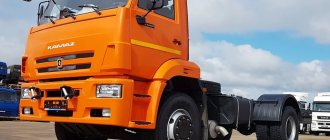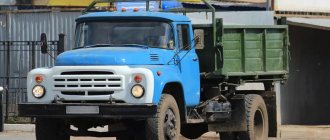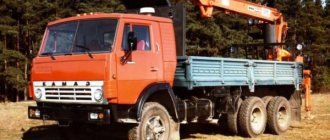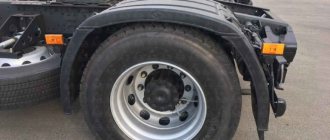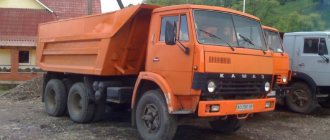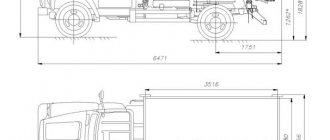ZIL-130 is a common Soviet-era truck. This is a highly functional, fast and quite comfortable technique. At the moment it is used for construction and agricultural purposes, but it is no longer a leader. To appreciate all the advantages of a vehicle, it is necessary to understand the features of its design, all technical characteristics and make sure of its adaptability to narrowly focused tasks. This truck has a high degree of maneuverability, since the weight of the ZIL-130 diesel dump truck is about 10 tons, just like KamAZ 55111.
Read the ranking of the top 5 largest mining dump trucks in the world.
About the manufacturer ZIL
ZIL - Likhachev Plant. Specializes in the production of passenger cars and trucks , as well as small-capacity buses. From the date of its founding until 2009, the company produced 7,870,089 trucks, 39,536 buses, and 12,148 cars. The KAMAZ plant is more productive; its KamAZ 6520 model is planned to be produced at 100 thousand units. annually. You may also be interested in an article about Kamaz brands and the length of Kamaz.
At the moment, production volume has been significantly reduced, and the company's priority activity has become the sale of objects in the field of heat and electricity.
Fiat 15 Ter / AMO-F15 (1916-1931)
It all started in 1916 with the Italian Fiat 15 Ter, a truck with a payload of 1.5 tons, which began to be produced in Italy three years earlier. This truck was equipped with a four-cylinder engine with a displacement of 4.4 liters and a power of 35 hp. and a four-speed gearbox.
In 1917-1919, the plant assembled trucks from Italian vehicle kits. The result of this activity is 1,300 finished cars.
In the fall of 1924, the plant assembled several AMO-F15s (the same Fiat 15 Ter), which became considered to be the first Soviet cars.
On November 7, a convoy of 10 such vehicles marched in a parade along Red Square, and on November 25, three trucks set off from Red Square on the first test run for the Soviet automobile industry along the route: Moscow - Tver - Novgorod - Leningrad - Vitebsk - Smolensk - Moscow.
In March 1925, serial production of AMO-F-15 vehicles began. In 1925, 113 such machines were produced, and in 1926 - 342. By 1931, 6971 copies of the AMO-F-15 were made.
Specifications
| Devices | Options |
| Chassis | ZIL-130B/ZIL-130B2 |
| Base, mm | 3800 |
| Engine | ZIL-130 |
| Power, hp (kW) | 150 (110.4) |
| Torque, Nm | 401.8 |
| checkpoint | Mechanical, 5-speed, synchronized |
| Wheel formula | 4x2 |
| Tire size | 260-508Р |
| Max. speed, km/h | 90 |
| Fuel tank capacity, l | 175 |
| Fuel consumption rate, l/100km | 37 |
| Working with a trailer | -/+ |
| Platform dimensions, LxWxH, mm | 3752x2325x575 |
| Platform area, m2 | 8,7 |
| Body volume, m3 | 5 |
| Climbing angle, degrees | 50 |
| Load capacity, kg | 4000 |
| Unloading direction (side/back) | +/+ |
| Overall dimensions, (length x width x height), mm | 6675x2500x2400 |
| Weight (how much it weighs), kg | 9360 |
ZIL-130 is a wide-profile truck that has a large number of varieties. The configuration of the vehicle brand influences the intended use for specific applications. ZIL-MMZ-555 has a shorter device than other models, which is necessary to increase the maneuverability of the structure. Compare with the technical characteristics of another dump truck - Tatra t815.
We also recommend that you familiarize yourself with the technical characteristics of the ZIL-131.
Dump truck models in the photo.
Popular manufacturer
Among the disadvantages, the first one that stands out is the possibility of unloading only from the rear position. To carry out correct interaction with the trailer, you must use the vehicle in the ZIL-130D1 configuration.
The ZIL-MMZ-554 device provides for the possibility of its use when carrying out work within the framework of agriculture. The design has a standard type frame , but can unload on one of 3 sides.
To ensure the proper functioning of a dump trailer, it is necessary to use a ZIL-130B2 machine, since the chassis of this design has the necessary devices for this. These models are distinguished by the fact that, with the help of employees, companies have been improved and modernized over short periods of time by adding new functions and enhancing capabilities.
Popular breakdowns of the ZIL-130 are caused by its design features. The following violations are possible:
- Abrasion of the piston rings, which occurs over a long period of use of the vehicle.
- Worn crankshaft seals.
- Littering of the special oil collection tube.
- Destruction of connecting rod heads , the location of which is the bottom panel.
Truck models
AMO-2 / AMO-3 / ZIS-5 (1930-1948)
The launch of the plant's second serial model, AMO-2, into mass production was the result of a major modernization and technical re-equipment of the enterprise carried out at the turn of the 20s/30s.
In 1930, the Soviet government purchased a license for the American Autocar-5S truck for production at the AMO plant. The truck, originally assembled from American vehicle kits, was named AMO-2. The car with a carrying capacity of 2.5 tons was equipped with a 4.9-liter inline six-cylinder engine with a power of 54 hp and a four-speed gearbox.
When production was localized and the first conveyor in the history of the USSR was launched (in 1931) and the conveyor was launched (the first in the USSR), it was renamed AMO-3. It was already a truck made entirely from domestic components.
Its engine power was increased to 72 hp. With. And in 1933, on its basis, the next main production model was made - the ZIS-5 truck, with a load capacity of 3 tons. But in fact it was still the same AMO-3.
In 1934, after the completion of a complete reconstruction of the enterprise (up to 100 thousand cars per year), this truck, which would become legendary in the future, went into mass production. Over sixty ZIS-5 trucks were produced per day. Based on this machine, 25 models and modifications were created, 19 of which also went into series.
ZIS-5, nicknamed “Zakhar” among drivers, was produced until 1948. More than half a million of these trucks were made. And together with those ZIS-5s that were produced in Ulyanovsk and Miass - about a million units. Compared to the base model, AMO-3, ZIS-5 had a payload capacity of 3000 kg, and its engine with a displacement of 5.6 liters already developed 73 hp.
Many modifications were also made based on the ZIS-5. These include gas generator and gas cylinder trucks, long-wheelbase versions of the ZIS-11 and ZIS-12.
Various machine modifications
There are a large number of modifications, each of which shows the best qualities of a particular model and emphasizes its advantages:
- 130A . Required in order to replace all the functionality of the onboard tractor. The weight of the device complete with trailer is 8 tons.
- 130G . The flatbed truck has a long wheelbase and is equipped with a special platform.
- 130V . Refers to the saddle system, designed to perform functions adapted to the tractor. This model has a shortened wheelbase.
- 130W . The main advantage here is the reinforced rear axle.
- 130B . This truck is designed in the form of a dump truck, as it is intended for work in agricultural activities.
Options featuring a reinforced rear axle showed that the overall weight of the structure increased significantly without the possibility of reduction, which often caused a decline in the overall performance of these models.
Specifications
This improvement has many advantages, including improved traction and dynamic characteristics . Simplified design options are available complete with a single-speed axle.
Explore Russian-made front loaders used in the construction and mining industries.
Their main technical characteristics are described in detail in our other article.
A separate article is devoted to Volvo backhoe loaders.
Tuning work
The ZIL power unit with an index of 130 and a volume of six liters has good characteristics that allow the truck to operate successfully in different conditions. However, it provides opportunities for tuning work, as a result of which it is possible to improve the dynamic parameters of the ZIL engine number 130. We list the types of actions taken to change the performance of this installation:
- Boring of cylindrical surfaces, carried out to expand the area of the chambers.
- Replacing the friction wheel - a wheel with teeth is installed.
- Shaft milling, replacement of tabs.
- Replacing the sparking mechanism with a non-contact device.
- Replacing the sprayer with an injection device with one nozzle.
It is also possible to carry out other tuning work that allows you to show improved characteristics.
Pros and cons of a dump truck
Advantages:
- The car operates at a record low cost (compare with the Chinese Shakman dump truck), since the cheapest gasoline is available, which is consumed in economy mode.
- Cargo transportation is carried out in accordance with the rules both on ordinary roads and in areas with poor quality surfaces.
- The turning radius is 7 m , which allows for comfortable movement where similar equipment cannot pass.
- Some modifications have modes for convenient handling of cargo, which allows you to load and unload it from any angle and to almost any place.
Flaws:
- The speed of the machines in most cases is limited to standard indicators, which is currently unacceptable in the conditions of delivery work.
- Truck load capacity is not a record.
- There are narrowly targeted models , the use of which limits the owner in many situations, which often provokes the need to purchase new cars.
Ergonomics
Almost the complete set of modifications of the ZIL-130 is equipped with an engine consisting of 8 cylinders (for example, Lawn Next has 4 cylinders). They are arranged in a standard sequence, forming the letter V. The motor operates on the principle of liquid cooling. Some types of trucks that were produced for export abroad were equipped with engines produced in other countries.
Sometimes a pre-start heater was installed in the design of the machines. This is necessary in cases where the machine is designed for use at low temperatures, that is, in harsh climatic conditions.
Dump truck ZIL-130
Transmission
ZIL-130 has a drive to the far axle. The clutch is designed on a dry principle and has 1 disc. The gearbox has 5 stages, operates on a mechanical principle, and is also characterized by 2 synchronizers. The gears of the gears are characterized by constant meshing. The exception is modules 1 and 5.
When this car first came off the assembly line, the design features of the gearbox seemed innovative to many. Subsequently, this device underwent many improvements, with the driven shaft undergoing special changes.
The outer neck of this device is marked with a special bearing. Many nodes have also undergone significant changes that are necessary to improve the model.
Features of work
The driveshaft in the design serves for optimal transmission of torque located on the reverse side of the axle, which is carried out as part of the gearbox system. The model developed according to the original plan and intended for agriculture, as well as its extended version, uses 2 shafts working with an intermediate type support. It is tightly attached to the frame.
There is a shortened version of this design, where there is 1 shaft, which requires an intermediate type support to support it.
DEVICE
The ZIL 130 had a design that was remarkable for its time (it is no coincidence that the model received a gold award at an international exhibition in Germany). The model received streamlined fenders, a ventilation hatch, a large panoramic windshield and an alligator-type hood. Typically the car was painted blue, but there were white, yellow and dark green variations.
The main elements of the ZIL 130 were installed on a riveted stamped frame with 2 channel-section spars. To strengthen the structure, 5 cross members were used. A hitch with a towing hook with a latch was mounted in the rear part, and 2 towing hooks without latches were mounted in the front part.
Chassis
For the front and rear axles, a dependent suspension with longitudinal semi-elliptic springs was used. The front ends of the springs were attached to the frame using pins and lugs, the rear ends were sliding. For the front axle, a forged I-beam was used with 2 double-acting telescopic hydraulic shock absorbers. The rear springs received a reinforced design.
The base for the car were 7.0-20 wheels with tires measuring 9.00-20 (260-20).
Transmission
Most versions of the ZIL 130 were equipped with a 5-speed three-way manual transmission with synchronization in all gears except first (the reverse gear was direct). The transmission of force from the engine to the gearbox was carried out using a dry single-plate friction type clutch with a mechanical drive. The main gear was double and had a gear ratio of 6.45. The rear post was equipped with a bevel differential with 4 satellites. The steering axle was the front axle, the driving axle was the rear axle.
Brake control
The working brake system of the ZIL 130 was of the shoe type with drum mechanisms acting on all wheels. The design included a pneumatic drive. A drum-type mechanism acting on the transmission was used as a parking system. It also had a mechanical drive.
Power supply system
The car used a single-wire electrical system with a voltage of 12 V. The energy source was a G108-V or 32.3701 type generator and a 6ST-90EM battery. An ST-130AZ starter was used to start the engine.
Cabin
In terms of comfort, the ZIL 130 was ahead of all other trucks of that time. The 3-seater all-metal cabin was located immediately behind the unit. The driver's seat was adjustable in height, backrest angle and length. All chairs were comfortable and soft. Basic options included a 2-blade windshield wiper, a windshield washer and a powerful heater. The ergonomics of the cabin were at a high level (especially for that time). Installed indicators and instruments provided complete information about the car. There were 2 ventilation hatches in the roof.
Sound insulation in the cabin was excellent. The main drawback of the cabin was poor visibility. The high front fenders and hood caused some problems, especially when driving in heavy traffic.
The width of the cabin has increased compared to other products from the plant, making the interior more spacious. In the initial version, the model was equipped with a hydraulic power steering, which ensured ease of driving a heavy truck. The steering mechanism itself included a screw with a ball-shaped nut and a piston-rack.
Body
ZIL 130 was supplied with a body with a hinged tailgate. The platform was considered a cargo-passenger platform, since it had bars and benches on the sides that could be folded down if necessary. The capacity of the body was 16 people. In the initial version, the car had an awning with arches. The basic body was highly practical and spacious. A shovel, blackout and canisters were offered as additional equipment.
Brake system
The internal structure of the ZIL-130 uses drum-type brakes . They are located on each wheel. They work through the functioning of a pneumatic system.
The main supply of air is contained in a separate pressure cylinder, which is pumped with the help of a compressor. It works using a belt drive.
Model 130
This compressor is designed from 2 cylinders, which, when working together, provide a capacity of 2000 rpm - 220 l/min. There is a parking brake, which is necessary to lock the driveshaft.
Engine
The first version of the model featured a carburetor-type engine, but it was put into operation only for experimental purposes. The system contained 6 cylinders, which were indicated on the diagram by a symbol similar to the letter “V”.
Later stages of development were marked by the use of 8 cylinders , which made it possible to increase engine power to 150 hp. With. The vehicle can reach a maximum speed of 90 km/h. This motor differs in the location of the valves, since they are all located on top.
General form
The maximum compression level is 6.5, with up to 3000 revolutions per minute. These are the highest figures.
The K-88 carburetor consists of 2 chambers. It is placed in the upper compartment and features a falling flow. The system attaches great importance to the accelerating pump, which operates on a mechanical principle. Its design includes a centrifugal regulator, which equalizes the crankshaft speed to the optimal level.
The motor is lubricated using pressure by spraying the required fluid. A filtration device is built into this system . In previous modifications, it was a composition of thin steel plates. To perform the highest quality cleaning, a special reactive centrifuge was used.
The engine is supported by the fuel pump. It has 2 intake and 1 exhaust valves. For the operation of the system, A-76 gasoline is selected.
The crankcase is blown using a closed principle. The VM-16 filter is necessary for air purification in 2 stages.
For comparison, you can read the article about the MAZ 5551 engine.
ZIS-150 / ZIS-151 (1947-1958)
Back in 1937, the plant produced the first prototype of a new generation truck. Its load capacity was increased to 5000 kg (on the highway, on dirt roads - 3500 kg). The car featured an all-metal three-seater cabin, a 100-liter fuel tank, boosted to 82 hp. motor.
Before the war, they did not have time to put the ZIS-150 into mass production, so the new, modern truck at that time went into production only in 1947. And in the first years of production, it was still made with a wooden-metal cabin.
ZIS-150
From 1947 to 1957, the company produced more than 770 thousand ZIS-150 trucks. Its 5.6-liter engine developed power of 90 and then 95 hp.
On the ZIS-150 platform, a three-axle all-terrain truck ZIS-151 was built, with a 6x6 wheel arrangement. It became the first domestic mass-produced car with three drive axles.
ZIS-151
The ZIS-151 was widely used in the Soviet Army - as a chassis for mounting multiple launch rocket systems, tankers, mobile communications equipment, and so on.
